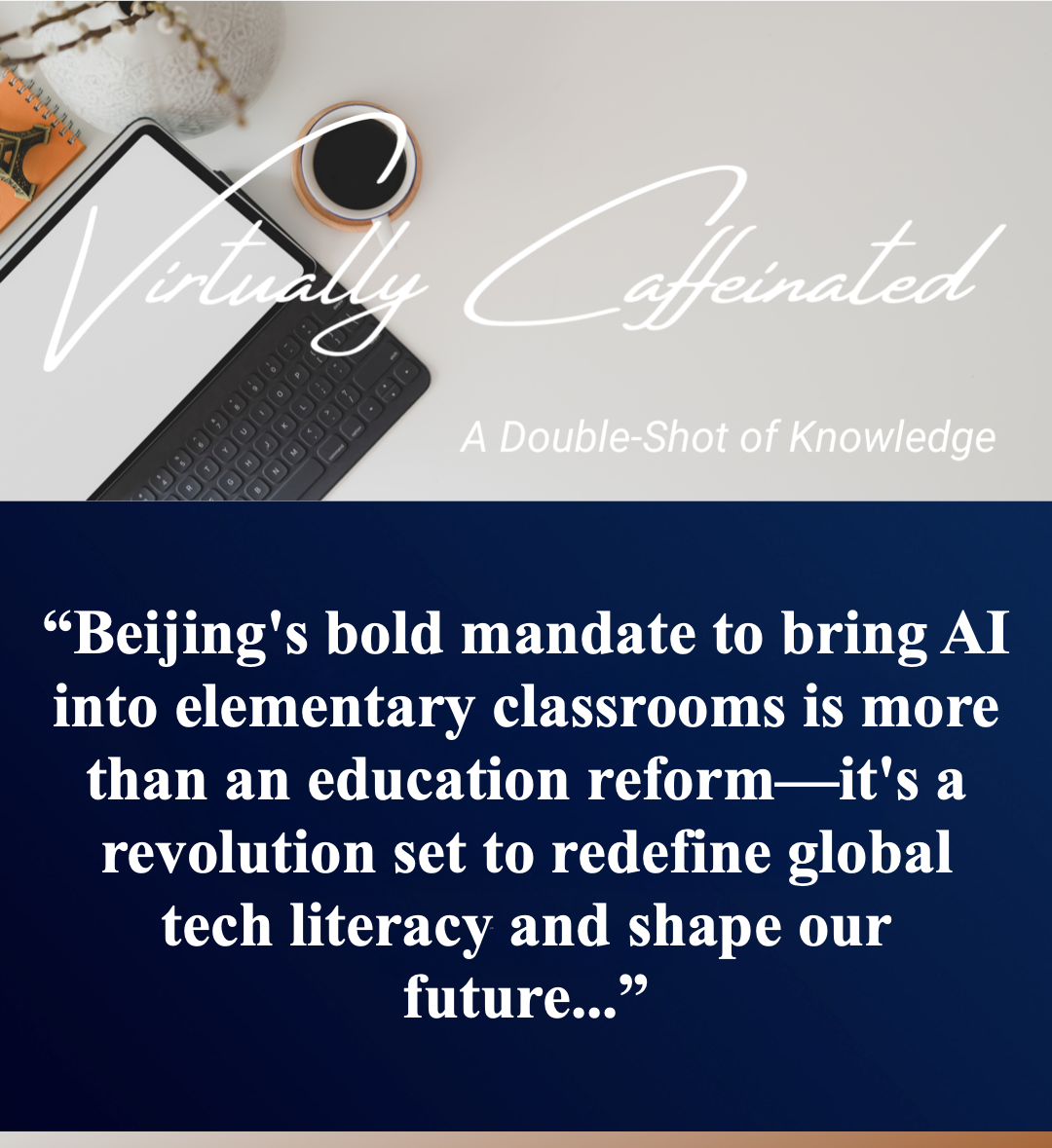Beijing’s Bold Mandate: How AI Education in Elementary Schools is Shaping the Future of Technology Literacy
In a groundbreaking move that promises to reshape the landscape of technology education, the Beijing municipal government has mandated that elementary schools integrate artificial intelligence (AI) into their curriculum. This initiative, which began in early 2025, represents a significant shift in educational policy and reflects the growing importance of AI in the modern world. By introducing AI at the elementary level, Beijing aims to equip young students with the skills and knowledge necessary to navigate and thrive in an increasingly digital and automated society.
Introduction
As the global economy becomes ever more reliant on advanced technology, nations around the world are racing to develop the next generation of tech-savvy professionals. Beijing’s decision to embed AI education into the fabric of its elementary school curriculum is a bold response to this challenge. The move is designed not only to foster technological literacy among children but also to position China as a leader in the development and application of AI technologies. This initiative is expected to have far-reaching implications, from boosting innovation to creating a more competitive workforce in the technology sector.
In this blog post, we explore the details of Beijing’s AI education mandate, discuss its potential benefits and challenges, and examine the broader impact on technology literacy and workforce development. We will also compare this approach with current practices in other parts of the world, highlighting the unique opportunities and potential pitfalls that lie ahead.
The Policy: A Vision for Future-Ready Education
Beijing’s mandate requires all public elementary schools to introduce AI-related courses by the start of the new academic year. The curriculum is designed to be age-appropriate and interactive, using a combination of classroom instruction, hands-on projects, and digital tools to engage students. Key components of the curriculum include:
- Basic AI Concepts: Students are introduced to foundational concepts such as machine learning, neural networks, and data processing in simplified terms.
- Practical Applications: Lessons include practical examples of how AI is used in everyday life—from virtual assistants to recommendation systems.
- Interactive Learning: The curriculum incorporates interactive tools and programming platforms that allow students to experiment with simple AI models, fostering creativity and problem-solving skills.
- Ethical Considerations: Teachers also discuss the ethical implications of AI, ensuring that students understand both the power and responsibility that come with advanced technology.
This policy is part of a broader strategy to modernize China’s education system and ensure that its youth are well-prepared for the challenges of the future. Officials believe that early exposure to AI will spark interest in science, technology, engineering, and mathematics (STEM) fields and will help create a more innovative, adaptable, and skilled workforce.
Benefits of Early AI Education
The benefits of introducing AI at the elementary level are manifold:
- Enhanced Critical Thinking:
Learning about AI encourages children to think logically and solve problems creatively. By engaging with complex concepts at an early age, students develop critical thinking skills that are essential in all areas of life. - Future-Proofing the Workforce:
As AI continues to transform industries, having a workforce that is comfortable with and knowledgeable about technology is crucial. Early AI education helps build a strong foundation for future careers in tech, ensuring that students are better prepared for the jobs of tomorrow. - Fostering Innovation:
Exposure to cutting-edge technology at a young age can inspire innovation. Students who learn about AI early on are more likely to pursue further studies in technology and contribute to future advancements in the field. - Bridging the Digital Divide:
By incorporating AI into the curriculum, Beijing is taking proactive steps to bridge the digital divide. Ensuring that all students, regardless of background, have access to advanced technology education helps promote equality and opportunity. - Ethical Awareness:
Integrating ethical discussions into AI education ensures that students are aware of the potential risks and societal impacts of technology. This early exposure can lead to a generation of tech professionals who prioritize ethical practices in their work.
Challenges and Considerations
While the mandate offers numerous benefits, it also presents several challenges that need careful management:
- Teacher Training:
One of the most significant challenges is ensuring that teachers are adequately prepared to deliver AI education. Many educators may lack the technical background necessary to teach these advanced concepts. To address this, Beijing has launched extensive training programs and partnered with tech companies to provide resources and support. - Curriculum Development:
Creating a curriculum that is both accessible and comprehensive for young students is no small feat. The content must be engaging, understandable, and relevant, all while covering complex topics. Curriculum developers are working closely with AI experts and educators to design lessons that meet these criteria. - Resource Allocation:
Implementing AI education requires investment in digital tools, hardware, and software. Not all schools may have equal access to these resources, which could lead to disparities in educational quality. The government is working to ensure that funding and resources are distributed equitably across all public schools. - Ethical and Privacy Concerns:
As students engage with AI, issues of data privacy and ethical use of technology become paramount. Schools must implement robust safeguards to protect students’ personal information and educate them about responsible technology use. - Cultural Adaptation:
Integrating AI into traditional education systems may require shifts in teaching methods and educational culture. Both students and educators must adapt to a new way of learning that emphasizes interactivity, creativity, and technology.
Global Comparisons and Future Outlook
Beijing’s mandate is not occurring in isolation. Globally, many countries are rethinking their education systems to better prepare students for a digital future. In the United States, for example, several school districts have introduced coding classes and STEM programs. However, Beijing’s approach is notably more ambitious, as it seeks to integrate AI directly into the curriculum from an early age.
European countries are also exploring ways to enhance digital literacy among young people, though the pace and scale of implementation vary widely. By contrast, Beijing’s centralized policy allows for a more uniform rollout, which could serve as a model for other nations seeking to modernize their educational systems.
Looking ahead, the long-term impact of Beijing’s AI education mandate could be transformative. As students grow up with a solid foundation in AI, they will likely be more adept at navigating and innovating in an increasingly tech-driven world. This could lead to a surge in tech startups, more robust research in AI, and a workforce that is better prepared to tackle the challenges of the 21st century. Moreover, the early focus on ethical considerations and responsible AI use may help foster a generation of innovators who are not only technically proficient but also ethically grounded.
Conclusion
Beijing’s mandate to integrate AI into elementary education is a bold and visionary step that could reshape the future of technology literacy. By equipping young students with the tools and knowledge to understand and harness AI, Beijing is laying the groundwork for a more innovative, efficient, and equitable future. The initiative not only promises to enhance academic outcomes but also aims to produce a generation of tech-savvy professionals ready to lead in the global digital economy.
As nations worldwide observe and learn from Beijing’s approach, the ripple effects of this policy may well drive a global transformation in education. Embracing AI at an early age could be the key to unlocking unprecedented levels of innovation and ensuring that the benefits of technology are shared across society. The journey ahead is both challenging and full of potential, and the success of initiatives like this will be a crucial measure of our collective ability to adapt to and thrive in a rapidly changing world.

